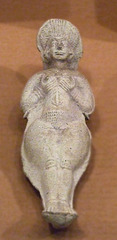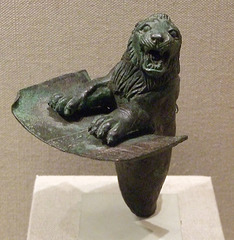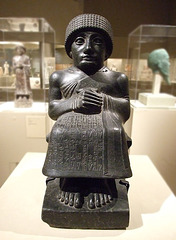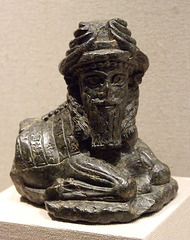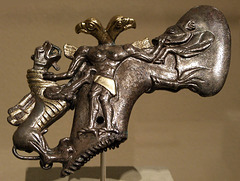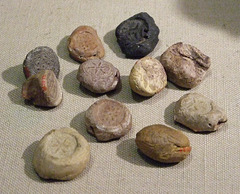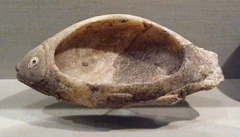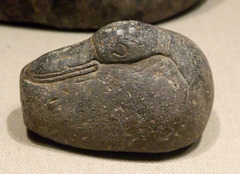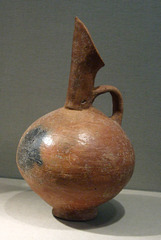
Metropolitan Museum V
Folder: Metropolitan Museum of Art
Metropolitan Museum of Art Set IV includes: Ancient Near East Islamic Art The Metropolitan Museum of Art, often referred to simply as The Met, is one of the world's largest and most important art museums. It is located on the eastern edge of Central Park in Manhattan, New York City, United States. The Met also maintains "The Cloisters", which features medieval art.The Met's permanent collection…
(read more)
Female Figure in the Metropolitan Museum of Art, A…
| |
|
Female Figure
Ceramic
Southwestern Iran, possibly Susa
Early 1st millennium BC
Accession # 51.7.1
Text from the Metropolitan Museum of Art label.
Head of a Ruler in the Metropolitan Museum of Art,…
| |
|
|
Head of a ruler, Akkadian (?), Early Bronze Age; 2300–2000 B.C.
Iran or Mesopotamia
Arsenical copper; H. 34.3 cm
Rogers Fund, 1947 (47.100.80)
During the later third millennium B.C., Mesopotamia was ruled by successive territorial empires. The first—the Akkadian Empire (2350–2150 B.C.)— was centered at Agade, a city still not located by archaeologists but probably near modern Baghdad. The official language of this empire was Akkadian, a Semitic language that differed greatly from Sumerian, which previously had been the predominant language of Mesopotamia. In addition to its political and economic innovations in administering a large territory, the Akkadian court produced innovative art in a powerful and naturalistic style.
This magnificent head portrays a king of the late third millennium B.C. Its heavy-lidded eyes, prominent but unexaggerated nose, full lips, and enlarged ears all suggest a portrait of an actual person. While the date and place of manufacture of this piece have been much debated, its close similarity to the magnificent bronze head found at Nineveh make a late third millennium date most likely. The head is cast almost solid (making it extremely heavy), but a dowel hole at the base would have served to join it to a body or other support, most likely for display in a temple setting.
Text from: www.metmuseum.org/Works_of_Art/viewOne.asp?dep=3&view...
Foundation Peg in the Form of the Forepart of a Li…
| |
|
Foundation Peg in the Form of the Forepart of a Lion
Bronze
Northeast Syria, probably Tell Mozan (ancient Urkish)
2200-2100 BC
Accession # 48.180
Inscribed in Hurrian, "Tish-atal, endan [king] of Urkish."
This figure would have been put in a ritual deposit under the wall of a temple, perhaps of the god Nergal.
Text from the Metropolitan Museum of Art label.
Foundation Peg in the Form of the Forepart of a Li…
| |
|
Title: Foundation peg in the form of the forepart of a lion
Period: Early Bronze Age
Date: 2200–2100 B.C.
Geography: Syria, probably from Tell Mozan (ancient Urkesh)
Medium: Copper alloy
Dimensions: H. 4 5/8 x W. 3 1/8 in. (11.7 x 7.9 cm)
Classification: Metalwork-Sculpture, Inscribed
Credit Line: Purchase, Joseph Pulitzer Bequest, 1948
Accession Number: 48.180
On View
Description:
After the collapse of the Akkadian Empire and a brief period of decentralized rule, a dynasty ruling from the southern Mesopotamian city of Ur took over a large area of Mesopotamia, including areas in the Zagros Mountains of Iran, and ruled for about one hundred years (2100–2000 B.C.). During this period, a number of minor rulers maintained their independence at the margins of the empire. Among them were the kingdoms of Urkish and Nawar in northern Mesopotamia, a Hurrian-speaking area.
Based on its inscription, this bronze foundation peg in the form of a snarling lion almost certainly comes from the city of Urkish, modern Tell Mozan. On a very similar piece now in the Louvre, the lion holds under its paws a white stone tablet with an inscription that names the temple of the god Nergal. Pegs of this and other forms were placed in foundation deposits under temple walls as a dedication to the god. Their appearance in northern Mesopotamia represents the adoption of a practice from the south.
Text from: www.metmuseum.org/Works_of_Art/collection_database/ancien...
Head of Gudea in the Metropolitan Museum of Art, J…
| |
|
Title: Head of Gudea
Period: Neo-Sumerian
Date: ca. 2090 B.C.
Geography: Mesopotamia, probably from Girsu (modern Tello)
Medium: Diorite
Dimensions: H. 10 1/16 x W. 7 9/16 x D. 9 15/16 in. (25.5 x 19.2 x 25.3 cm)
Classification: Stone-Sculpture
Credit Line: Fletcher Fund, 1949
Accession Number: 49.26
Text from: www.metmuseum.org/Works_of_Art/collection_database/ancien...
Seated Statue of Gudea in the Metropolitan Museum…
| |
|
Seated statue of Gudea, 2150–2100 B.C.; Neo-Sumerian period
Probably Tello (ancient Girsu), southern Mesopotamia
Diorite; H. 17 3/8 in. (44 cm)
Harris Brisbane Dick Fund, 1959 (59.2)
The Akkadian empire collapsed after two centuries of rule, and during the succeeding fifty years, local kings ruled independent city-states in southern Mesopotamia. The city-state of Lagash produced a remarkable number of statues of its kings as well as Sumerian literary hymns and prayers under the rule of Gudea (ca. 2150–2125 B.C.) and his son Ur-Ningirsu (ca. 2125–2100 B.C.). Unlike the art of the Akkadian period, which was characterized by dynamic naturalism, the works produced by this Neo-Sumerian culture are pervaded by a sense of pious reserve and serenity.
This sculpture belongs to a series of diorite statues commissioned by Gudea, who devoted his energies to rebuilding the great temples of Lagash and installing statues of himself in them. Many inscribed with his name and divine dedications survive. Here, Gudea is depicted in the seated pose of a ruler before his subjects, his hands folded in a traditional gesture of greeting and prayer. The Sumerian inscription on his robe lists the various temples that he built or renovated in Lagash and names the statue itself, "Gudea, the man who built the temple; may his life be long."
Text from: www.metmuseum.org/toah/ho/02/wam/hod_59.2.htm
Seated Statue of Gudea in the Metropolitan Museum…
| |
|
Seated statue of Gudea, 2150–2100 B.C.; Neo-Sumerian period
Probably Tello (ancient Girsu), southern Mesopotamia
Diorite; H. 17 3/8 in. (44 cm)
Harris Brisbane Dick Fund, 1959 (59.2)
The Akkadian empire collapsed after two centuries of rule, and during the succeeding fifty years, local kings ruled independent city-states in southern Mesopotamia. The city-state of Lagash produced a remarkable number of statues of its kings as well as Sumerian literary hymns and prayers under the rule of Gudea (ca. 2150–2125 B.C.) and his son Ur-Ningirsu (ca. 2125–2100 B.C.). Unlike the art of the Akkadian period, which was characterized by dynamic naturalism, the works produced by this Neo-Sumerian culture are pervaded by a sense of pious reserve and serenity.
This sculpture belongs to a series of diorite statues commissioned by Gudea, who devoted his energies to rebuilding the great temples of Lagash and installing statues of himself in them. Many inscribed with his name and divine dedications survive. Here, Gudea is depicted in the seated pose of a ruler before his subjects, his hands folded in a traditional gesture of greeting and prayer. The Sumerian inscription on his robe lists the various temples that he built or renovated in Lagash and names the statue itself, "Gudea, the man who built the temple; may his life be long."
Text from: www.metmuseum.org/toah/ho/02/wam/hod_59.2.htm
Seated Statue of Gudea in the Metropolitan Museum…
| |
|
Seated statue of Gudea, 2150–2100 B.C.; Neo-Sumerian period
Probably Tello (ancient Girsu), southern Mesopotamia
Diorite; H. 17 3/8 in. (44 cm)
Harris Brisbane Dick Fund, 1959 (59.2)
The Akkadian empire collapsed after two centuries of rule, and during the succeeding fifty years, local kings ruled independent city-states in southern Mesopotamia. The city-state of Lagash produced a remarkable number of statues of its kings as well as Sumerian literary hymns and prayers under the rule of Gudea (ca. 2150–2125 B.C.) and his son Ur-Ningirsu (ca. 2125–2100 B.C.). Unlike the art of the Akkadian period, which was characterized by dynamic naturalism, the works produced by this Neo-Sumerian culture are pervaded by a sense of pious reserve and serenity.
This sculpture belongs to a series of diorite statues commissioned by Gudea, who devoted his energies to rebuilding the great temples of Lagash and installing statues of himself in them. Many inscribed with his name and divine dedications survive. Here, Gudea is depicted in the seated pose of a ruler before his subjects, his hands folded in a traditional gesture of greeting and prayer. The Sumerian inscription on his robe lists the various temples that he built or renovated in Lagash and names the statue itself, "Gudea, the man who built the temple; may his life be long."
Text from: www.metmuseum.org/toah/ho/02/wam/hod_59.2.htm
Human-Headed Bison in the Metropolitan Museum of A…
| |
|
Human-headed bison
Serpentine (lizardite)
Southern Mesopotamia, probably Tello (ancient Girsu)
Reign of Ur-Ningirsu of Lagash, 2150-2100 BC
Accession # 1996.353
This creature, known as a kusarikku and associated with the sun god Shamash, wears the horned headdress of a divinity. Originally, another figure or element must have been set into the cavity on the back. The sculpture is dedicated to the goddess Nanshe for the life of the Sumerian ruler Ur-Ningirsu. The name of the donor is not preserved.
Text from the Metropolitan Museum of Art label.
Smiting Weather God and Enthroned Deity in the Met…
| |
|
Shaft-hole Axe Head with a Bird-Headed Demon, a Bo…
| |
|
Shaft-hole Axe Head with a Bird-Headed Demon, a Boar, and a Dragon
Silver, gold foil
Central Asia (Bactria- Margiana)
Late 3rd- early 2nd millennium BC
Accession # 1982.5
The bird-headed demon depicted on both sides of the axe (rather than being double-headed) holds a winged dragon in one claw and a boar, which forms the cutting edge of the axe, in the other. The image possibly represents the bird-demon as a hero mastering chaos in the form of the boar and the dragon.
Text from the Metropolitan Museum of Art label.
Mesopotamian Nude Standing Figure in the Metropoli…
| |
|
Nude standing female
Ceramic
Central Mesopotamia, excavated at Tell Asmar (ancient Eshnunna)
Ur III, or Isin-Larsa period, 2100-1900 BC
From the expedition of the Oriental Insitute of the University of Chicago to Iraq, 1930-38.
Accession # 51.25.12
Text from the Metropolitan Museum of Art label.
Ancient Stamp Seal Impressions in the Metropolitan…
| |
|
Fish-Shaped Vessel in the Metropolitan Museum of A…
| |
|
Title: Fish-shaped vessel
Period: Middle-Late Bronze Age
Date: 2nd millennium B.C.
Geography: Syria
Medium: Gypsum alabaster, shell
Dimensions: 2 1/2 x 9 1/4 in. (6.4 x 23.4 cm)
Classification: Stone-Vessel
Credit Line: Gift of Sheldon and Barbara Breitbart, 1984
Accession Number: 1984.453.2
On View
Text from: www.metmuseum.org/Works_of_Art/collection_database/ancien...
Seated Female in the Metropolitan Museum of Art, F…
| |
|
Seated female
Steatite or chlorite, limestone
Central Asia (Bactria-Margiana)
Late 3rd, early 2nd millennium BC
Accession # 1989.281.41 a,b
Three-dimensional composite figures of seated females wearing voluminous sheepskin robes probably represented divinities. This type of figure was also engraved on seals of the Old Elamite period (2000-1800 BC) from southern Iran.
Text from the Metropolitan Museum of Art label.
Weight in the Shape of a Duck in the Metropolitan…
| |
|
Spouted Jug with Raised Concentric Circles in the…
| |
|
Spouted Jug with Raised Concentric Circles
Ceramic
Northwestern Anatolia
Early Bronze Age II, 2700-2400 BC
Accession # 60.83.7
Text from the Metropolitan Museum of Art label.
Spouted Jug With a Mottled Surface in the Metropol…
| |
|
Spouted Jug With a Mottled Surface
Ceramic
Northwestern Anatolia
Early Bronze Age II, 2700-2400 BC
Acccession # 62.65.3
Text from the Metropolitan Museum of Art label
Jump to top
RSS feed- Latest items - Subscribe to the latest items added to this album
- ipernity © 2007-2024
- Help & Contact
|
Club news
|
About ipernity
|
History |
ipernity Club & Prices |
Guide of good conduct
Donate | Group guidelines | Privacy policy | Terms of use | Statutes | In memoria -
Facebook
Twitter

